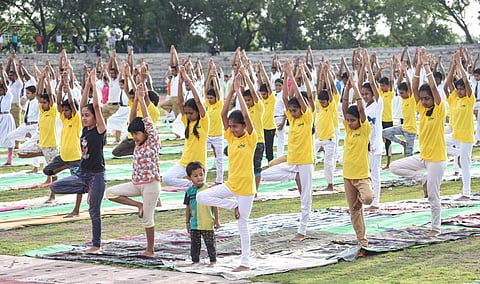

How often have you found your child glued to multiple digital screens and felt helpless about it? Are you concerned about your child’s health, mind and future? After all, temper tantrums, reduced attention span, lethargy, poor memory, decreased immunity, obesity and junk food cravings are all on the rise these days.
If children continue to be unhappy despite getting everything delivered at lightning speed, it will affect their patience (mind) and blood circulation (blood pressure). A non-content attitude will deviate their focus on unimportant things, making them uncompetitive, physically slower and argumentative, with less appreciation for the environment. It is important to decode the principles of our ancestral science of movement and calmness on the human body and mind. Acknowledging the environment, our children should be able to harness the Power of the Sun and accept the calmness of the moon by performing Suryanamaskars on waking up and Chandranamaskars at dusk.
Both the salutations are a comprehensive and fun workout for children, comprising of eight powerful postures incorporating breath control, postural movements and meditation. Though elementary, they are an effective form of yoga for children and can be modified through different intensity levels to get the desired rewards. Children of eight years and above should do the Namaskar series once a day; first slow with about three to five repetitions to improve mental skills, and then fast, around 10-15 repetitions to improve cardio fitness.
The benefits of Namaskars for children are many, among them are digital detox, reducing digital obsession, improving imagination and creativity. Secondly, they calm the nervous system and increase patience, self-awareness, confidence and help overcome stage fright.
Done regularly, they also optimise metabolism and improve immunity and strength. Lastly, yoga teaches children to love and embrace themselves, fostering their self-esteem.
Benefits of children practising yoga:
Improves Memory and Attention Span
Practising yoga encourages children to have a clearer mind and focus on their academic performance and extra-curricular activities. Yoga is also beneficial for children suffering from special disorders like ADHD (Attention Deficit Hyperactivity Disorder) by reducing some of its core symptoms like hyperactivity, impulsivity and inattentiveness.
Healthy eating habit developed in kids
Yoga helps in developing healthy eating habits in children, which helps in maintaining a calm and focused mindset.
Yoga teaches self- acceptance and builds confidence
Yoga allows children to learn and move at their own pace in mastering new poses, which helps in building confidence by creating a flow between their body and mind. An added advantage by learning yoga at a young age are incredibly valuable lessons helping in a fight the increasing feelings of self- doubt that a child faces during their teenage and beyond.
Improves balance
Systemic breathing and exercise are an integral part of yoga and balancing both are very essential to achieve its benefits. By practicing this from a young age child becomes more aware of the human system and its functions and also the significance of balancing life through yoga.
Yoga enhances immunity
Children often fall sick due to the lack of immunity in their body. Yoga helps in overcoming it by stimulating the nerves, endocrine, digestive and circulatory systems which enhances their functioning. Some asanas and deep breathing techniques assist in safeguarding one from falling prey to germs causing diseases.
